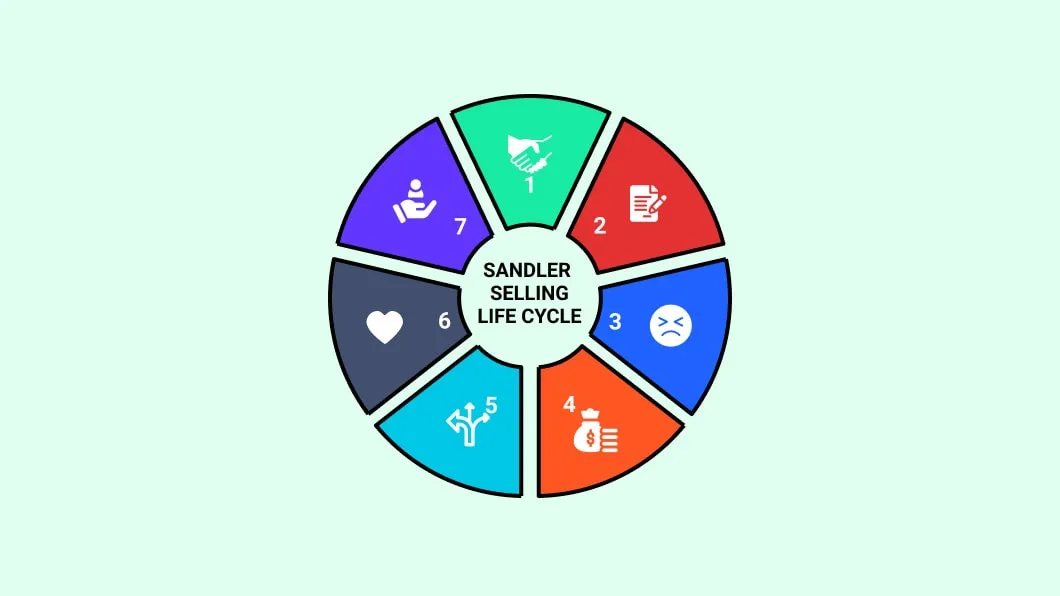The Sandler Training Sales System has been around for decades and has a proven process that changes how salespeople interact with prospects.
In this article we’ll get into 10 Sandler training sales techniques that will transform your sales process. You’ll learn how sandler sales training sets clear expectations, navigate complex decision making and maintain relationships long after the sale is done.
Sandler selling methodology is not just a theory—these are proven steps from sales reps who have done it. So if you want to get better at sales, read on and see how the Sandler Selling System can deliver real results.
What is the Sandler Selling System?

The Sandler Selling System is a proven method that helps sales professionals succeed. Developed by David Sandler in the 1960s, it focuses on building trust and guiding the next sales rep to process smoothly.
This system is different from traditional selling methods because it puts the customer's needs first.
The Sandler Selling System uses clear steps to make sales easier, leading to better sales success. Sales professionals who use this system often see a significant increase in their sales numbers.
According to a study by the Sales Management Association, companies using structured sales methods like the Sandler system can see up to a 28% improvement in their sales performance
7 Important Steps in Sandler Sales Method

1. Build Trust with the Buyer
Building trust is the foundation of any successful sale. Without trust, it’s hard to move forward in the sales process. The Sandler Sales Method emphasizes the importance of connecting with the buyer on a personal level.
Listen Actively: Pay close attention to what the buyer says. Show that you care about their needs and concerns.
Ask Questions: Use questions to understand the buyer’s pain points and what they are looking for in a solution.
Be Honest: Always be upfront about what you can and cannot offer. Transparency helps build long-lasting relationships.
2. Set Clear Expectations on Upfront Contract
Setting clear expectations and transparent sales process from the beginning is crucial. This is where the “upfront contract” comes into play. It’s a simple agreement between you and the buyer that outlines what will happen next.
Define the Next Steps: Clearly explain what the buyer can expect after each meeting or call.
Agree on Timeframes: Make sure both you and the buyer are on the same page regarding timelines.
Clarify Responsibilities: Let the buyer know what you will do and what you need from them.
An upfront contract reduces confusion and ensures that everyone knows what to expect. This step in the Sandler Sales Method helps prevent misunderstandings and keeps the sales process smooth.
3. Identify and Address Potential Roadblocks
Every sales process has potential roadblocks. These are issues that could slow down or stop the sale from happening. The Sandler Sales Method teaches you to identify these roadblocks early and address them head-on.
Ask About Concerns: Directly ask the buyer if they have any concerns about your product or service.
Discuss Budget: Make sure the buyer’s budget aligns with your offering. If not, find out what adjustments can be made.
Identify Decision Makers: Understand who will make the final decision and what factors are important to them.
Refining your selling process ensures that each step is efficient and buyer-focused.
4. Discuss Budget and Decision-Making
Discussing the budget and understanding the decision-making and existing sales process are crucial steps in the Sandler Sales Method. By tackling these issues early, you can avoid surprises later.
Ask About the Budget Early: Understand the customer’s budget to see if your solution fits within their financial constraints. This helps avoid wasting time on deals that won't work out.
Identify Decision Makers: Find out who will be making the final decision. It’s important to know who has the authority to approve the purchase.
Clarify Priorities: Ask the customer what factors are most important in their decision. This could be price, quality, or something else. Understanding their priorities helps you tailor your pitch.
5. Show How Your Solution Fits Their Needs
Once you understand the customer’s budget and decision-making process, it’s time to show how your solution fits their needs. This is where you can really shine.
Highlight Key Benefits: Focus on how your product or service solves the customer’s problems. Make sure to link these benefits to the priorities they mentioned earlier.
Use Data: Provide data or case studies that show how your solution has helped other customers. Numbers add credibility to your claims.
Address Concerns: If the customer has any concerns, address them directly. This shows that you’re listening and that you care about their success.
6. Get Agreement to Move Forward
The final step is to get the customer’s agreement to move forward. This is where all your hard work pays off.
Ask for a Commitment: Once the customer is satisfied with your solution, ask for their commitment to move forward. This could be signing a contract, setting up a trial, or scheduling the next meeting.
Clarify Next Steps: Make sure the customer knows what will happen next. This keeps the process smooth and avoids confusion.
Stay Positive: Even if the customer isn’t ready to commit right away, keep the conversation positive. Encourage them to think about the benefits of your solution and stay in touch.
7. Maintain a Strong Relationship Post-Sale
Maintaining a relationship with your customer after the sale is just as important as making the sale itself. A strong post-sale relationship leads to repeat business and positive referrals, which are essential for long-term success.
Follow Up Regularly: Keep in touch with your customer after the sale. A quick email or call to check in can go a long way in showing that you care about their success.
Address Any Issues: If your customer has any concerns or problems, address them quickly. This shows that you stand by your product or service.
Offer Continued Support: Let your customer know that you are available to help them with any future needs. This builds trust and encourages them to come back to you when they need more help.
10 Key Techniques in Sandler Sales Methodology

1. Identify and Address the Prospect's Pain Points
Understanding and addressing your prospect’s pain points is the foundation of successful selling. Pain points are the specific problems or challenges that your prospect is facing.
Why It Matters:
When you identify and address these pain points, you show the prospect that you genuinely care about solving their problems. This builds trust and makes it easier to move the sales process forward.
How to Implement:
- Pose Open-Ended Questions: Begin by asking questions that prompt the prospect to discuss their challenges. For example, “What is the biggest challenge you’re facing in your current process?”
- Listen Actively: Pay close attention to their responses, and take notes on the key issues they mention.
- Present Relevant Solutions: Tailor your pitch to address these specific pain points, showing how your product or service can help.
2. Guide the Sales Process with the Sandler Submarine
The Sandler Submarine is a visual metaphor used to describe the stages of the Sandler Sales Process. It includes steps like bonding and rapport, setting an upfront contract, and qualifying the prospect.
Why It Matters:
The Sandler Submarine helps you guide the prospect through each stage of the sales process, ensuring that you don’t skip critical steps. This systematic approach keeps the process smooth and increases the chances of a successful sale.
How to Implement:
- Start with Bonding and Rapport: Build a strong relationship with the prospect by finding common ground and showing genuine interest in their needs.
- Set an Upfront Contract: Clearly outline what will happen during your conversation and what both parties can expect. This sets the stage for a transparent and productive discussion.
- Qualify the Prospect: Use qualifying questions to determine if the prospect is a good fit for your solution. For example, ask about their budget, decision-making process, and timeline.
A clear sales process like the Sandler Submarine can help you stay on track and avoid common pitfalls. By following this method, all sales managers and professionals can navigate complex sales situations with confidence.
3. Avoid Pushy Sales Tactics
Pushy sales tactics involve aggressive techniques that pressure the prospect into making a decision. These tactics can include constant follow-ups, not respecting the prospect’s time, or using fear-based selling.
Why It Matters:
Avoiding pushy sales tactics is crucial because they can damage the trust you’ve built with the prospect. Customers are more informed than ever, and they don’t respond well to high-pressure, sales calls.
How to Implement:
- Respect the Prospect’s Time: Be mindful of their schedule, and don’t overwhelm them with too many follow-ups.
- Provide Value in Every Interaction: Instead of pushing for a sale, focus on providing useful information and solutions that genuinely help the prospect.
- Be Patient: Allow the prospect to make their decision at their own pace. Keep the communication open, but don’t rush them.
4. Qualify Leads with the Sandler Sales System
Qualifying leads is the process of determining whether a prospect is a good fit for your product or service. The Sandler Sales System provides a structured way to do this.
Why It Matters:
By qualifying leads early, you save time and resources by focusing on prospects who are more likely to convert. This ensures that your sales efforts are targeted and effective.
How to Implement:
- Ask Key Questions: Use the Sandler Sales System to ask questions about the prospect’s needs, budget, and decision-making process. For example, "What are the key challenges you’re facing right now?"
- Evaluate Fit: Based on their responses, determine if your solution meets their needs and if they have the budget to move forward.
- Prioritize Leads: Focus on prospects who are ready to make a decision and have the resources to buy. This helps you close deals more efficiently.
5. Strengthen Sales Reps' Focus on the Buyer’s Needs
Focusing on the buyer’s needs means understanding what the buyer wants and tailoring your sales model and approach to meet those needs.
Why It Matters:
When sales reps focus on the buyer’s needs, they build trust and create stronger relationships. This customer-centric approach is essential for closing sales and maintaining long-term relationships.
How to Implement:
- Listen Actively: Encourage your sales reps to listen carefully to what the buyer is saying. This involves asking open-ended questions and letting the buyer explain their situation.
- Personalize Your Approach: Tailor your pitch based on the specific needs of the buyer. Highlight how your product can solve their problems and improve their situation.
- Follow Up Thoughtfully: After your initial conversation, follow up with information that is relevant to the buyer’s needs. This could be a case study, a product demo, or a personalized offer.
6. Navigate the Buying Process with the Sandler Method
The buying process refers to the steps a buyer goes through before making a purchase decision. The Sandler Method helps you guide the buyer through this process smoothly.
Why It Matters:
Successfully navigating the buying process ensures that the buyer feels supported and confident in their decision. This increases the likelihood of a successful sale.
How to Implement:
- Clarify Each Step: Clearly outline the steps in the buying process, from the initial meeting to the final decision. This helps set clear expectations and reduces uncertainty.
- Provide Guidance: Use the Sandler Method to guide the buyer through each stage, offering support and answering any questions they may have.
- Address Concerns: Be proactive in addressing any concerns or objections the buyer might have. This builds trust and helps move the process forward.
7. Build Mutual Trust to Repeat Business
Building mutual trust with your clients means creating a relationship where both parties feel confident and secure. Trust is the foundation of any relationship building any long-lasting business relationship.
Why It Matters:
When clients trust you, they are more likely to return for repeat business. Trust also leads to positive word-of-mouth, which can bring in new customers.
How to Implement:
- Be Transparent: Always be honest about what your product can and cannot do. If there are limitations, let your client know upfront.
- Follow Through on Promises: If you say you will do something, make sure you do it. Keeping your promises builds credibility and trust.
- Be Consistent: Regularly check in with your clients and provide consistent service. This shows that you value their business and are committed to helping them succeed.
8. Create Open and Honest Communication Channels
Open and honest communication channels are lines of communication where clients feel comfortable sharing their thoughts, concerns, and needs with you.
Why It Matters:
Open communication ensures that there are no misunderstandings between you and your client. It also helps in resolving issues quickly before they escalate.
How to Implement:
- Ask for Feedback: Regularly ask your clients for feedback on your services. This shows that you care about their experience and are open to making improvements.
- Be Accessible: Make it easy for your clients to reach you. Whether it’s through email, phone, or in-person meetings, ensure that they know how to get in touch with you.
- Address Issues Promptly: If a client brings up a concern, address it as soon as possible. This shows that you take their feedback seriously and are committed to resolving any issues.
9. Use Consultative Selling for Strong Client Relationships
Consultative selling is a sales approach where the salesperson acts as an advisor, helping the client find solutions that best meet their needs.
Why It Matters:
This approach builds strong client relationships because it focuses on understanding the client’s needs and providing tailored solutions. Clients appreciate when a salesperson takes the time to understand their unique challenges and offers personalized recommendations.
How to Implement:
- Ask Deep Questions: Go beyond surface-level questions and ask about the client’s goals, challenges, and long-term plans. This will help you understand their needs better.
- Offer Tailored Solutions: Based on the information you gather, recommend solutions that are specifically designed to meet the client’s needs. Avoid generic pitches.
- Be a Resource: Position yourself as a resource for your clients, offering advice and insights even after the sale is made. This keeps the relationship strong and opens up opportunities for future business.
10. Turn Every "No" into a Learning Opportunity
Hearing "No" from a prospect can feel discouraging, but in Sandler training sales, it's an opportunity. Each rejection helps you understand what didn't work, so you can improve your approach.
Why It Matters:
Learning from "No" helps you refine your sales process. Instead of seeing rejection as a failure, view it as valuable feedback. This mindset shift can lead to better strategies and, eventually, more "Yes" responses.
How to Implement:
- Ask Why: After a rejection, politely ask the prospect why they said no. Understanding their reasons gives you insight into what you can improve.
- Review Your Approach: Look back at your sales pitch. Did you miss any key points? Were there objections you didn't address? Analyzing your approach helps you identify areas for growth.
- Make Adjustments: Based on the feedback, tweak your sales method. Maybe it’s a matter of timing, the way you present your solution, or understanding the prospect's pain points better.
Conclusion
The Sandler training sales methodology offers a powerful approach to improving your sales process. By focusing on the buyer’s needs and building mutual trust, you can create strong, long-lasting client relationships. Use these proven techniques to guide your sales team and achieve lasting customer success now. Remember, every "No" is just an opportunity to learn and grow.





.jpg)

.jpg)
